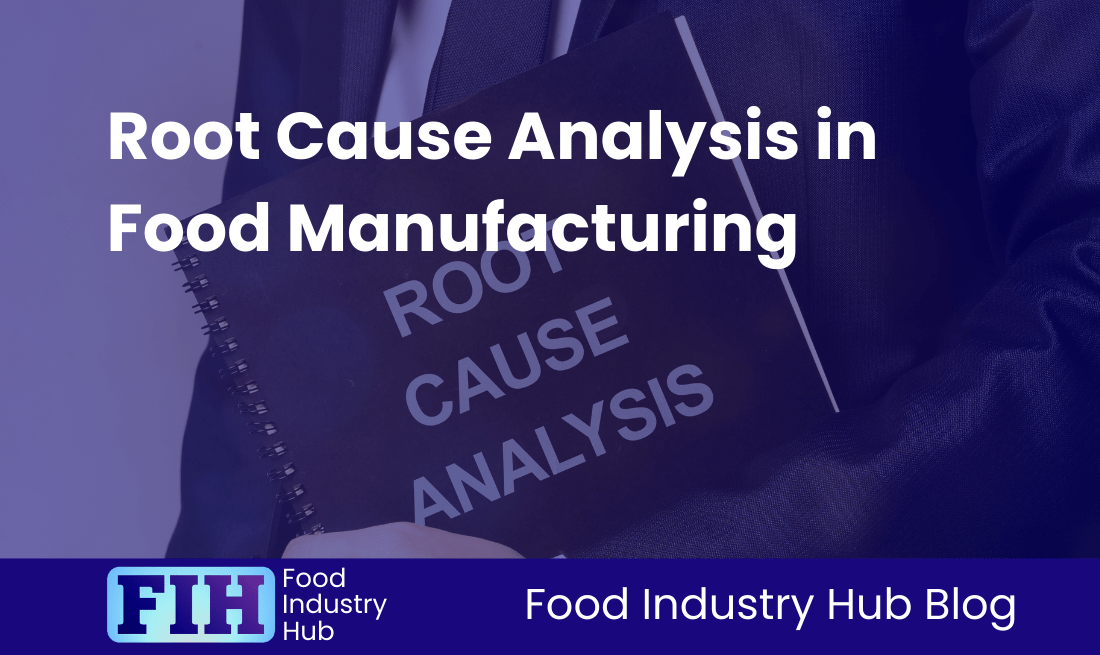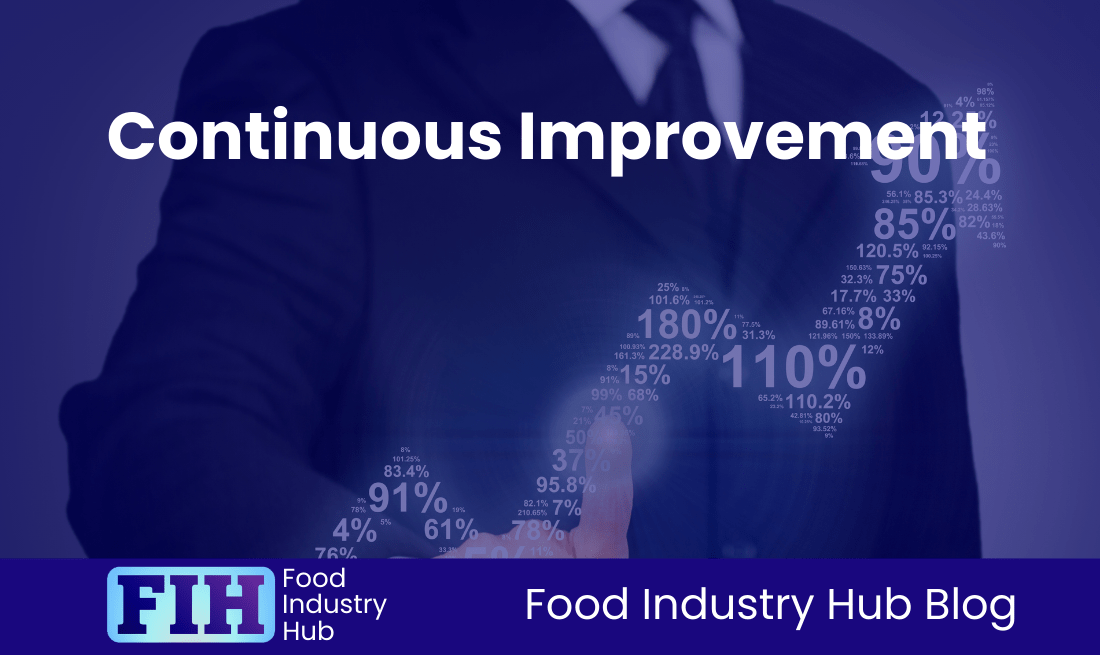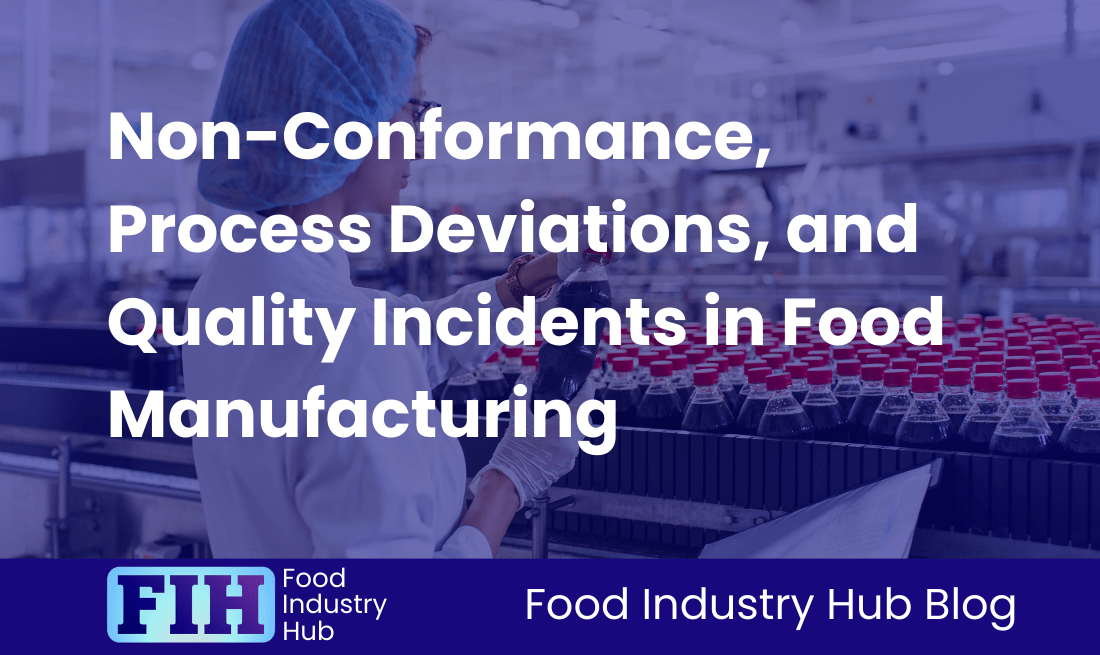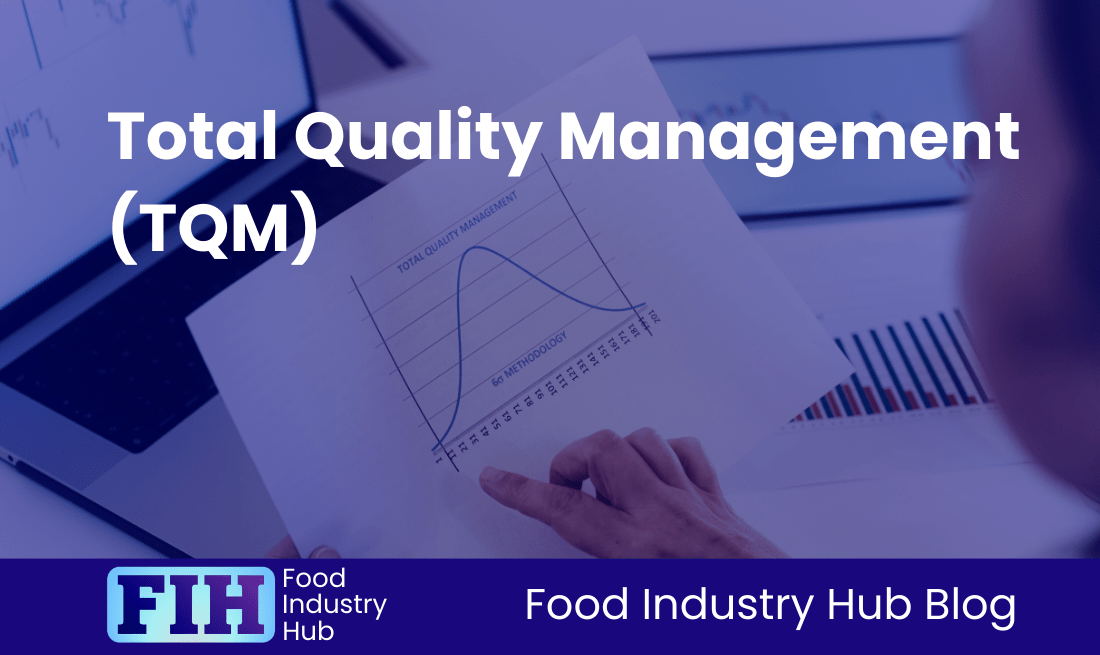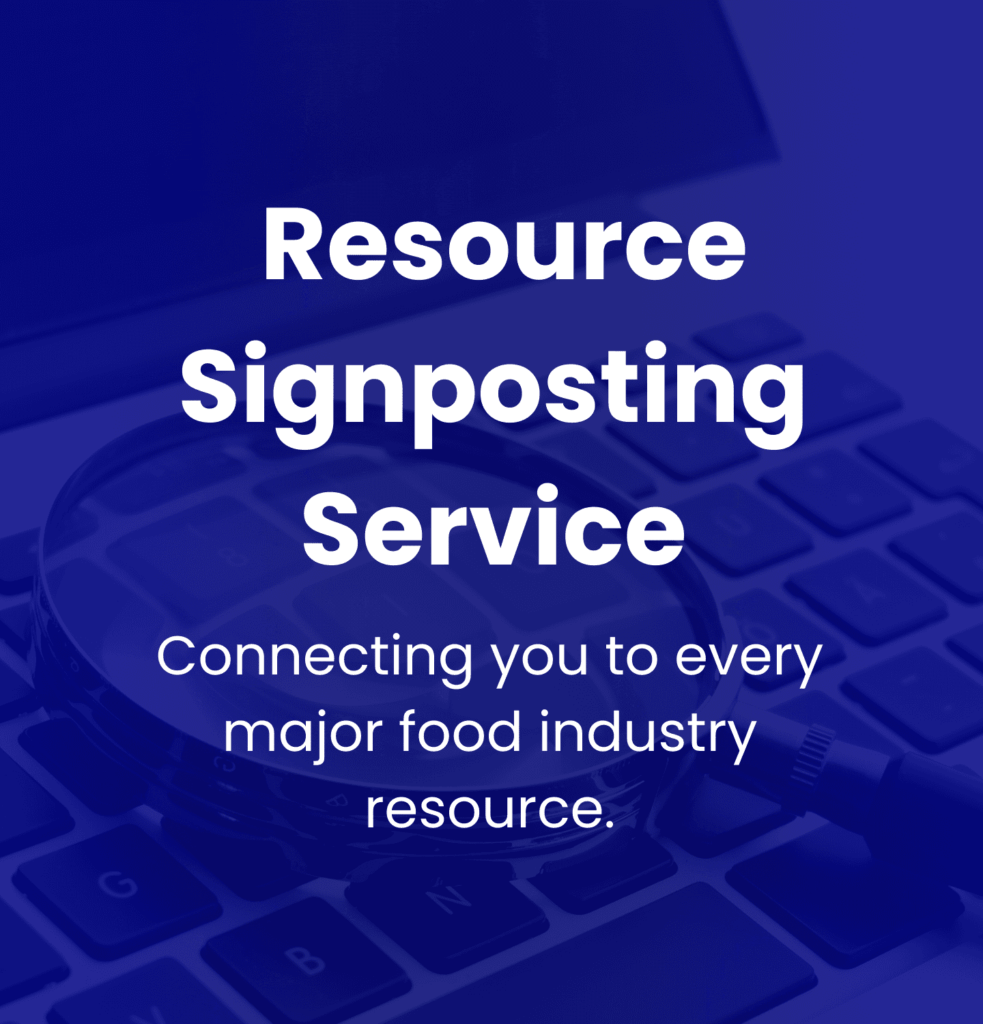Know: Root Cause Analysis (RCA)
Introduction
In food manufacturing, Root Cause Analysis (RCA) is an invaluable tool for improvement. It helps identify and address system issues before they escalate into major problems like foodborne illnesses, product defects, and operational inefficiencies. By exploring the root causes of these problems, measures can be put in place that not only maintain compliance with regulations, but also ensure the consistent production of safe, quality products.
RCA, a systematic approach used to pinpoint the primary reasons behind problems or incidents, goes deeper than the surface-level symptoms. Within the food manufacturing industry, the role of RCA is not merely confined to compliance; it is instrumental in averting outbreaks, improving product quality, controlling costs, and ensuring safety. Through detailed investigations of the root causes of issues –whether they be microbiological, chemical, or physical contaminants — RCA aids in preventing food safety incidents and validates that production processes continually adhere to safety and quality standards. This process plays an essential role in maintaining regulatory compliance. It identifies and corrects non-conformances, preventing potential disruptions to operational solidity.
Significance of RCA
The importance of RCA in identifying and rectifying systemic shortcomings in food manufacturing operations cannot be overstated. The RCA approach provides a blueprint for locating vulnerabilities within production systems and optimises operational efficiencies. This reduces downtime and fosters a positive work environment. RCA ensures that products meet the requisite quality standards, thus maintaining consumer trust and compliance with regulatory requirements.
We will look into several key themes associated with RCA in the food manufacturing industry, including the principles and methodologies used in RCA, its contribution to regulatory compliance and food safety systems. The impact of emerging technologies on enhancing RCA’s effectiveness, the role of human factors in successful RCA implementation, and prevalent global trends in practice will also be examined. As organisations gain insight into these themes, they will be better equipped to utilise RCA in strengthening safety protocols, enhancing quality, and meeting compliance norms within their operations.
Key Takeaways
Root Cause Analysis (RCA) significantly bolsters food safety measures and quality assurance practices. By unravelling the underlying causes of incidents, RCA shifts the problem-solving paradigm from reactive responses to proactive prevention. This approach lends itself to resolving fundamental issues instead of merely focusing on the symptoms, eventually paving the way for operational enhancement and productive stakeholder collaboration. Implementing RCA and building a culture centered around it leads to actionable insights, which open avenues for precise corrective actions geared towards ramping up both quality and safety.
RCA underpins regulatory compliance, deemed particularly valuable within the ambit of systems like the US FDA’s Food Safety Modernisation Act (FSMA). Through the systematic identification of deviations from important safety limits, food manufacturers can fine-tune their practices to align with regulatory criteria, thus avoiding potential legal issues. Complete documentation of RCA processes denotes commitment to safety and due diligence, adding an extra layer of protection against non-compliance problems.
Infusing RCA methodologies with pioneering data analytics and technological tools considerably boosts the identification of root causes. Embracing advanced analytical tools can bring about improved data-driven decision-making. Utilising modern technology can streamline the RCA process, mechanise data collection, and hasten responses to revealed issues, thereby supporting more resilient systems.
A prominent role is played by human input in the effective execution of RCA. Obstacles like training deficiencies and communication barriers can impede the process, thereby underlining the necessity to nurture a culture that stimulates reportitng and participation. Joint efforts play a key role as the dynamics of diverse teams add to more exhaustive problem-solving methodologies, thus simplifying the conversion of RCA findings into tangible actions.
RCA practices display noticeable regional variations influenced by the local regulatory environment, cultural attitudes towards safety, and technology adoption levels. Amidst these disparities, a clear trend towards the digitisation of RCA processes is discernible. The blending of AI and machine learning tools is becoming a regular feature, infusing predictive capabilities vital in enhancing the potency of RCA. As the worldwide food landscape progresses, standardised RCA approaches are increasingly esteemed for the uniformity they bring to safety practices, irrespective of geographical boundaries.
Food Industry Hub Management Systems can significantly boost the effectiveness of your food safety and quality management system, leading to improved confidence and elevated quality assurance throughout your operations.
RCA: Understanding the Basics
Purpose of RCA in Identifying Systemic Issues and Contributing Factors
Root Cause Analysis (RCA) is an essential tool within the food manufacturing industry, dealing with investigating and discerning the driving factors behind incidents such as foodborne illnesses or contamination occurrences. The chief aim of RCA is to methodically spotlight the root causes of these events, facilitating the construction of effective remedial measures. These solutions tackle immediate issues, whilst deterring future repeats of such incidents [Source: Pew].
This process is instrumental in addressing systemic weak spots such as human error, inadequate operational procedures, or non-adherence to safety standards. RCA in practice can identify problems like microbiological contamination, potentially caused by deficient sanitation procedures or lack of proper employee training. By utilising tools like the Fishbone Diagram or the 5 Whys technique, food manufacturers can detect multilevel contributing factors that give rise to problems, thereby forming comprehensive solutions that bolster safety, quality, and regulatory compliance.
Examination of Regulatory Incentives Promoting RCA Adoption
Regulatory incentives play a significant role in driving the adoption of RCA within food manufacturing. Bodies like the U.S. Food and Drug Administration (FDA) promote the incorporation of RCA as part of the Food Safety Modernization Act (FSMA), which encourages a proactive approach to food safety through preventive controls. This regulatory structure aligns with guidelines that mandate manufacturers to identify and reduce risks within their operations.
Meeting regulatory criteria not only aids the protection of public health but optimises operational efficiencies. It reduces the risk of non-compliance and lessens the probability of costly recalls. Facilities that sustain a systematic RCA process quite naturally prioritise detailed documentation, contributing to a transparent compliance process and promoting continuous improvement.
Transformational Impact of Cross-Industry Knowledge Sharing on RCA Application
Sharing knowledge across industries offers dynamic opportunities for refining the use of RCA within the food manufacturing sector. The integration of best practices and techniques from sectors such as healthcare and automotive allow food companies to significantly enhance their RCA procedures. The pharmaceutical sector’s Failure Mode and Effects Analysis (FMEA) can assist in prioritising inherent food safety risks, while the implementation of real-time monitoring systems from the automotive industry may guide deviation management strategies.
This collective approach fosters an anticipatory safety culture, equipping food manufacturers to foresee potential hurdles and create innovative solutions that streamline operations, ultimately enhancing consumer safety and product authenticity.
Terminology and Interrelationships within RCA
Insights into Key Terms and Implications
Contributing Factors: These elements, while not the primary cause, significantly shape the occurrence of certain outcomes. Understanding contributing factors in RCA is highly important, as they assist in creating corrective measures that address both root and contributory causes, thereby delivering comprehensive solutions.
Preventive Controls: These measures are put in place to circumvent issues or lower the probability of safety hazards. RCA informs the formation and optimisation of preventive controls, integrated within quality management frameworks such as Hazard Analysis Critical Control Point (HACCP). Understanding the root causes of hazards leads to more effective preventive strategies, as a direct result enhancing regulatory compliance.
Discussion on the Connection between RCA, Regulatory Compliance, Data, and Technology
RCA is inextricably connected with regulatory compliance in the food industry, influencing manufacturers to establish systems that can identify and rectify issues. Advanced data analytics and digital tools greatly enhance RCA processes, allowing the identification of systemic issues by detecting patterns and trends. The efficiency and potency of RCA applications are consequently improved.
Frameworks, such as ISO 22000, stress the importance of record-keeping and data utilisation in making food safety decisions, highlighting the synergy between RCA practices, regulatory compliance requirements, and the technological interfaces bolstering safety management systems in food manufacturing.
Proven Methodologies for RCA
Root Cause Analysis (RCA) is significant in the food manufacturing industry as it aids in understanding the fundamental causes of quality and safety issues, instead of just addressing visible symptoms. Two widely utilised RCA methodologies in the food manufacturing industry notably include the 5 Whys and Fishbone diagrams.
The 5 Whys Technique
The 5 Whys method is a simple but effective tool that aids in understanding an issue by repeatedly asking “why.” This method is not rigid and may involve different numbers of “why” based on the issue’s complexity. For instance, in a scenario where a batch of food products is contaminated, the first question might be, “Why was the batch contaminated?” Sequential questioning can help in identifying various layers of the cause, potentially leading to insights about inadequate sanitation practices or equipment malfunctions. The method understandably becomes less effective for complex issues due to its simplicity.
Fishbone Diagram (Ishikawa Diagram)
Another useful RCA method is the Fishbone Diagram, or the Ishikawa Diagram. This method helps in visually categorising potential issue causes into significant categories such as People, Methods, Machines, Materials, Measurement, and Environment. This thought-out approach supports brainstorming and aids teams in comprehensively exploring all possible failure avenues. Consequently, it is particularly effective for complex issues like contamination or product recall scenarios [Source: Food Safety Magazine].
Hybrid Approaches
Hybrid methodologies blend different RCA methods to effectively tackle complex scenarios. Ideally, one might start with the Fishbone Diagram to identify general potential causes and then utilise the 5 Whys to narrow down specific issues. This blended approach enhances the depth of analysis and helps food manufacturing teams understand complex incidents better [Source: Klipspringer]. Other combinations may include integrating Pareto Analysis with traditional RCA methods, potentially identifying high-impact issues that require immediate attention thereby making resource allocation more effective.
RCA Methodology Terminology
Pareto Analysis is an RCA tool that uses the 80/20 principle, which suggests that about 80% of problems can be traced back to 20% of causes. By applying this method, food manufacturers can focus their resolution efforts on significant issues impacting food safety and quality, effectively refining operational focus and resource allocation.
The term Causal Mechanism points to the series of events that connect a root cause to its observable effects. Having a clear comprehension of these mechanisms can assist food manufacturers in creating effective corrective measures. Understanding the causal relationships is a key element in promoting a culture of continued improvement in food safety systems.
Integration with Food Safety Management Systems
RCA methodologies have an integral role in food safety management systems like HACCP (Hazard Analysis and Critical Control Points), ISO 22000, and GFSI-benchmarked assurance schemes. These established systems require systematic analysis to effectively discover and mitigate potential hazards. Incorporating RCA in these systems helps businesses adhere to compliance standards while improving food safety. This is due to RCA’s ability to identify and solve root causes before they develop into significant safety incidents.
An active approach to identification and analysis ensures that food manufacturing operations not only comply with necessary regulations but also uphold an environment conducive to continuous improvement, leading to enhanced product quality and consumer safety.
Sign-up for the Food Industry Hub Mail Service
We regularly produce new content for food industry professionals, and the Food Industry Hub Mail Service is the best way to stay up to date with the latest additions.
Signup today to be added to the Food Industry Hub mailing list.
Legislative Compliance and RCA
In the UK, Root Cause Analysis (RCA) forms a key aspect of food safety management systems, working hand-in-hand with legal frameworks such as the Food Safety Act and the Food Law Code of Practice. Despite not being explicitly mandated by law, food businesses must conduct RCA following food safety incidents, guided by the Food Standards Agency (FSA). The FSA stresses the importance of immediate and transparent reporting of such incidents, alongside performing an RCA to identify suitable corrective actions to prevent potential recurrences. This rigorous approach aims to safeguard public health and boost consumer trust by ensuring effective adherence to food safety protocols in the industry [Source: Food Standards Agency].
Comparative Viewpoints on RCA Reporting Regulations in Various Regions
The approach taken by the UK contrasts with those of other regions, such as the US and the EU, with each having distinct expectations in relation to RCA reporting. In the US, the Food and Drug Administration (FDA) incorporates RCA as part of its wider food safety measures, emphasising its role in their “New Era of Smarter Food Safety” initiative. This implementation stresses the significance of RCA in curbing food contamination hazards.
Significance of FDA’s Emphasis on Transparency and its Influence on RCA Outcomes
Under its “New Era of Smarter Food Safety” blueprint launched in 2020, the FDA underlines the requirement to promptly deploy RCA teams to perform comprehensive investigations post-incident and share conclusions with relevant parties [Source: Pew Trusts]. This policy encourages improvements in food safety protocols while also promoting an environment of transparency within the industry, improving communication and shared responsibility.
The FDA promotes transparency in conducting effective RCA, encouraging manufacturers to actively engage in the RCA process and boosting the overall safety culture of the industry. The FDA’s drive towards transparency is aimed not only at reducing incidents of foodborne illnesses but also in enhancing public trust, clearly illustrating how open communication can improve RCA outcomes [Source: FDA].
Insights into the EU’s RASFF System and Its Effect on RCA Practices
In the European Union, the Rapid Alert System for Food and Feed (RASFF) plays a pivotal role in managing food safety risks across member countries. It enables prompt communication about potential food safety threats, ensuring swift responses to validated risks. However, the operational requirements of the RASFF may at times pose a conflict with the detailed investigative processes attached to RCA. The immediate need to issue alerts and execute corrective actions can disproportionately focus attention away from the all-encompassing analyses required for RCA. Consequently, food manufacturers may place a higher priority on instantaneous containment of food safety issues over comprehensive RCA, potentially compromising the extraction of long-term preventative insights.
Despite possible challenges, RASFF reinforces the need for RCA, as effective responses to food safety alerts require a solid understanding of the root causes of incidents. Therefore, a balance between swift risk management and thorough RCA is key to improving food safety practices across the EU [Source: RASFF].
Key Terms in Regulatory Compliance
Understanding Key Terminologies: Corrective Action Plan, Near-Miss Event
A Corrective Action Plan (CAP) is an integral element of RCA. It delineates the specific measures a food business will implement after a root cause investigation. The CAP details actions necessary to rectify identified shortcomings, assigns roles and responsibilities, establishes timelines, and sets up verification processes to ascertain the effectiveness of corrective actions. Many regulatory frameworks deem CAPs a legal requirement, underscoring their importance in compliance.
In contrast, a Near-Miss Event refers to a situation that could have resulted in a breach of safety or contamination but was fortunately avoided. Proactive documentation and analysis of near-miss incidents enable food manufacturers to identify weaknesses in their processes and put into place preventive safeguards. This proactive approach is essential in cultivating a safety culture within food manufacturing operations, supporting continuous improvement initiatives.
Influence of Regulatory Compliance on Global RCA Implementation
The worldwide implementation of RCA in food manufacturing is considerably influenced by obligations related to regulatory compliance. Regulations from international bodies such as the FDA, the UK’s FSA, and directives in the EU, all dictate that food businesses integrate RCA into their operational structures. This assures that issues identified through RCA are addressed in line with legal standards, thereby promoting a culture of accountability and improved food safety practices.
Regulatory pressures push food manufacturers to incorporate RCA into their broader food safety management systems, such as Hazard Analysis and Critical Control Points (HACCP). This continuous focus on compliance solidifies the significance of RCA as a strategic tool for averting food safety incidents and enhancing product quality. Additionally, the growing emphasis on transparency in communicating RCA findings to stakeholders facilitates ongoing enhancements and heightens industry standards, even as regional differences pose challenges for multinational businesses attempting to standardise their RCA methodologies.
RCA and Integration with Food Safety Systems
In the food manufacturing industry, Root Cause Analysis (RCA) plays a central role, specifically when it comes to enhancing Hazard Analysis and Critical Control Points (HACCP) procedures. While HACCP is a foundational system for the assurance of food safety, its success often depends on the detection and closure of any existent shortcomings. RCA provides teams with a systematic process to tackle weaknesses within HACCP plans by analysing anomalies or failures. For instance, should multiple contamination events occur, RCA may help pinpoint significant areas of concern such as insufficient critical control point (CCP) monitoring or failures in verification. This analysis can shed light on instances where HACCP protocols may be lacking in terms of preventative control. Emphasised in the FDA’s Smarter Food Safety Blueprint is the necessity of RCA in harnessing data and enhancing preventive systems to ward off risks before they escalate into severe food safety issues.
Importance and Process of Implementing Prompt Corrective Actions Driven by RCA Findings
In maintaining food safety and operational efficiency, it’s essential to put into motion swift corrective actions following RCA findings. Once the root cause is identified, a structured protocol is usually adopted. This process begins with the immediate containment of the issue to avoid additional risks, followed by the creation of a corrective action plan, specifically designed to rectify the identified root cause. For instance, if RCA indicates that a Listeria outbreak springs from substandard cleaning procedures, corrective measures might involve improving sanitation practices and employee training, rather than just discarding contaminated products. Such targeted interventions not only rectify the immediate problem but also strengthen the overall robustness of food safety systems by preventing the recurrence of similar issues.
Synergies Between RCA Practices and Auditing Systems for Continuous Improvements
Amalgamating RCA practices with auditing systems gives rise to a strong synergy, championing continuous improvement within food safety management. While audits generally expose compliance gaps or operational inefficiencies, RCA delves into the root of persistent issues. For example, a food safety audit may spot allergen mislabelling, leading to an RCA enquiry that uncovers systemic failures in labelling controls or staff training. By using insights from RCA to inform audit processes, organisations not only bolster compliance but also implement systemic changes that nurture a culture of accountability and proactive risk management.
How RCA Fortifies Data Integrity and Allows Advanced Technological Applications in Food Safety
RCA strengthens data integrity by basing the analysis of incidents on accurate and comprehensive data, thus ensuring the trustworthiness of root cause findings. This thoroughness is vital when advanced technological solutions are applied in food safety. Technologies that utilise RCA data—like predictive analytics and digital monitoring systems—empower food manufacturers to foresee possible risks and effectively advance food safety protocols. For example, deploying IoT-enabled sensors enhances real-time CCP monitoring, minimises human error and offers valuable data for RCA investigations. The integration of cutting-edge technology into RCA not only maximises food safety management but also strengthens traceability and documentation processes – indispensable factors for regulatory compliance.
Tailoring these strategies, food manufacturers can address root causes of failures, amplify product quality, and remain compliant with rigorous food safety regulations.
RCA and Technological Leverage
Digital traceability is now a central element in executing Root Cause Analysis (RCA) within the food manufacturing industry. Using software solutions, manufacturers can keep a close track of their products from their initial production stages, through various supply chain processes. By providing transparency, digital traceability enhances the manufacturer’s ability to accurately identify contamination sources and quality concerns at a fast pace. The implementation of digital systems are, as per FDA’s New Era of Smarter Food Safety Blueprint, instrumental in encouraging an efficient food safety ecosystem. This technology stimulates quicker investigations and promotes swift responses to potential risks, thereby minimising the dangers associated with foodborne illnesses. The use of digital technologies aids food manufacturers in introducing a strong framework that not only expedites the RCA process but also facilitates establishing preventive remedies after issues are identified.
The Influence of Predictive Analytics in Preventing and Resolving Issues
Predictive analytics have been instrumental in changing the way RCA is carried out, moving it from being reactive to a more proactive method in managing food safety. With the ability to analyse historical data and real-time information, this technology can predict any potential quality and safety issues. With these insights, manufacturers can resolve problems before they escalate into serious concerns. Predictive models can uncover patterns that may signal potential failures, prompting timely interventions. The FDA emphasises the importance of integrating predictive technologies into food safety strategies to enhance compliance and operational efficiency. Proactive data use not only controls the risks associated with food recalls but also results in improved financial outcomes for companies by reducing compliance failures and associated penalties.
Benefits of Using Cloud-Based Data Storage for RCA Data Management
In managing the extensive data requirements of RCA in food manufacturing, cloud-based data storage systems prove to be particularly effective. These platforms deliver a centralised hub for collecting, storing, and analysing data related to food safety incidents and investigations. Some of the benefits of using such systems include the ability to access real-time data conveniently. This data access capability facilitates RCA initiatives across multiple teams and locations, ultimately making the problem-solving process more efficient. In addition, cloud solutions enhance scalability to accommodate varying data demands and improve data integrity and security. The amalgamation of advanced analytics and IoT data on this platform significantly optimises the effectiveness and efficiency of RCA processes in the complex food supply chains of today.
Terminology in Technology for RCA
Root Cause Cluster Analysis (RCCA) is a progressive approach that groups similar causes from various incidents to efficiently identify systemic issues within food manufacturing processes. This technique utilises data aggregation methods to identify patterns that might not be noticeable in isolated case evaluations. Consequently, companies can implement more substantial corrective and preventive strategies. This type of analysis is essential in sectors encountering complex food safety challenges as it provides valuable insights leading to substantial improvements.
IoT-Enabled Sensors have brought about significant changes in data collection methods within the food manufacturing sector. These sensors continuously monitor factors such as temperature, humidity, and sanitation levels, providing essential real-time data that can issue alerts for deviations that might lead to quality issues. Incorporating these sensors into RCA processes enhances the precision and speed of interventions, allowing manufacturers to address potential problems promptly before they become significant incidents.
Enhancing Global Applicability and Efficiency with Technological Tools
Utilising technological advancements such as digital traceability systems, IoT sensors, and cloud-based storage can standardise data collection and analytical practices, thereby improving the global applicability of RCA. These innovations enhance real-time monitoring capabilities, leading to faster trend identification and anomaly detection across international supply chains. Companies that use these tools align better with best practices and regulations worldwide, thus promoting a safer food environment. By integrating these systems, manufacturers not only enhance their RCA processes but are also better equipped to navigate the complexities of food safety in the global marketplace.
Human Factors in RCA
Cultural Competency Gaps and RCA Training
In food manufacturing, the emphasis on cultural competency is growing, as it is seen as a vital factor to increase the efficiency of Root Cause Analysis (RCA). Cultural competency gaps showcase the disparity in cultural backgrounds and communication styles among team members. These disparities can trigger misunderstandings which could hamper the uncovering and rectification of root issues during RCA studies. Hence, it’s important for RCA training schemes to feature elements enhancing cultural knowledge and sensitivity. Such initiatives should aim to enable effective communication and collaboration among diverse teams, assuring the integration of multiple viewpoints into the problem-solving process. Organisations placing importance on cultural competency not only experience improved communication, but also achieve more precise RCA outcomes. This is done by gathering insights from a wide range of experiences and viewpoints, ultimately elevating food safety and quality measures [Source: Pew].
Relevance of Cross-Functional Teams in RCA Studies
The intricate and interlinked nature of food manufacturing processes highlight the need for cross-functional teams during RCA studies. Teams like these commonly comprise professionals from various departments such as production, quality assurance, maintenance, and regulatory compliance. They offer a comprehensive examination of incidents. This inclusive collaboration ensures contemplation of all significant factors, minimising the chances of overlooking key elements that could improve food safety and operational efficiency. Complex problems typically arise from a spectrum of causes rather than a single factor. This makes the presence of diverse expertise crucial for in-depth analyses and effective solutions. Plus, organisations utilising cross-functional teams can cultivate a culture of ongoing improvement, enhancing the effectiveness of their RCA methods and promoting a safer work environment.
Consequences of Cognitive Biases on RCA Effectiveness Evaluation
Cognitive biases can significantly compromise the precision and dependability of RCA efforts in the food industry. Common cognitive biases like confirmation bias, which biases the analysis towards data supporting pre-existing beliefs, and anchoring bias, where initial information disproportionately impacts subsequent evaluations can result in incomplete investigations and misinterpretation of root causes. To counter these biases, RCA teams ought to adopt structured methodologies such as the 5 Whys or Fishbone diagrams. These facilitate objective, evidence-based analyses and promote systematic problem-solving. Additionally, creating an environment that prioritises open discussion can lessen the impact of individual biases, improving team dynamics and the depth of analysis.
Terminology in Human Factors
Human Error Analysis
Human Error Analysis (HEA) is a vital aspect of RCA, focused on identifying how and why human activities lead to errors within processes. In the food manufacturing sector, understanding the sources and types of human errors such as those stemming from inadequate training or poor workplace ergonomics, is crucial for devising targeted interventions. By using methodologies like the Human Factors Analysis and Classification System (HFACS) organisations can categorise human errors, ultimately simplifying the identification of systemic issues that require resolution for improved safety and operational outcomes [Source: Food Protection Trends].
Organisational Learning
Organisational Learning pertains to the mechanisms through which organisations reincorporate the knowledge gleaned from previous experiences, specifically RCA findings, into ongoing operations. It is essential in food manufacturing to have an environment where insights from past incidents are systematically used to refine safety protocols. This adaptive ability can significantly decrease the chances of repetition of problems while enhancing overall food safety practices within the organisation. Organisations efficiently engaging in continuous learning are in a stronger position to adhere to varying regulations while ensuring a high standard of food production quality.
Interaction Between Regulatory Compliance and Human Factors
Particularly in the food manufacturing sector, the correlation between regulatory compliance and human factors is quite noticeable. Often, organisations find that human errors are linked to systemic conditions like insufficient training or unclear communication which, if rectified, can strengthen compliance with safety standards. To ensure corrective actions not only meet regulatory expectations but also genuinely improve operational effectiveness and safety practices, RCA must incorporate these human elements. By aligning RCA initiatives with compliance obligations, organisations can build a safer production environment while reinforcing adherence to external standards and practices.
RCA: Global Perspectives and Emerging Trends
The adoption and application of Root Cause Analysis (RCA) within the food manufacturing sector exhibit noticeable diversity, largely due to local regulations, cultural practices, and industry benchmarks.
Comparative Study of RCA Practices Across Different Regions
In the UK and EU, the practice of integrating RCA with Hazard Analysis and Critical Control Points (HACCP) schemes is often propelled by regulatory requirements. This in-depth approach upholds compliance with rigorous food safety laws laid down by the European Food Safety Authority (EFSA) and the UK’s Food Standards Agency (FSA). Both the UK and EU prioritise risk management strategies that situate RCA as an essential element of their operational structures, essentially viewing it as a preventive tool rather than a reactive response to failure.
On the other hand, North American practices, particularly as framed within the FDA’s New Era of Smarter Food Safety Blueprint, focus on the role of technology and data analytics in augmenting RCA capacities. The framework encourages food companies to combine the use of predictive analytics with regular RCA methods to encourage a shift towards future-oriented food safety initiatives. On the contrary, regions with less defined regulatory environments may be slower to adopt RCA methodologies or might merely apply them reactively, due to differing levels of industrial development.
Futuristic Look at the Role of Climate Change on RCA Methodologies
Climate change presents new difficulties for food manufacturing, necessitating modifications in RCA methodologies to account for new risks. Increasingly unpredictable weather patterns can interrupt supply chains, allow the spread of pathogens, and threaten food safety. Thus, manufacturers must adjust their RCA practices to integrate climate risk assessments, enabling them to predict potential disruptions and establish preventive measures.
RCA methodologies should take advantage of data analytics and modelling tools to proactively assess the environmental impacts on food safety. For example, the possibility of increased pest activity or shifts in pathogen presence call for a heightened focus on hazard analysis and control protocols. This represents a fundamental move towards resilience in food manufacturing processes amidst climate unpredictability.
Understanding the Role of Global Forums Like the GFSI in Standardising RCA Practices
Global forums such as the Global Food Safety Initiative (GFSI) play a crucial role in creating standardised RCA practices across the food supply chain. By offering a framework for industry best practices, GFSI simplifies the implementation of comprehensive RCA protocols through recognised certification schemes such as BRCGS and FSSC 22000. These initiatives promote consistency in the way various stakeholders approach root cause identification and mitigation, thereby improving food safety globally.
The GFSI also champions the adoption of advanced methodologies—including Fishbone Diagrams and the 5 Whys approach—essential for conducting effective RCA in tackling food safety issues. The push for standardising these practices through certification creates a cohesive environment for international cooperation, significantly elevating standards across borders while ensuring that diverse regulatory frameworks do not compromise consumer safety.
Understanding Global Terminology
Definition and Interpretation of Significant Global Terms
Transboundary RCA: This concept refers to the collaborative RCA efforts across national borders, vital for addressing food safety incidents that involve multi-national supply chains. It underscores the necessity for coordinated efforts amid global trade, especially during food safety emergencies where contamination issues may emerge simultaneously in multiple jurisdictions.
One Health RCA: This approach blends the interdependence of human, animal, and environmental health within RCA frameworks. By addressing the root causes of food safety issues, such as zoonotic diseases, this method aims to provide a more holistic understanding of food safety challenges and incorporate these insights into analyses.
Analysis of Global Data and Tech Tools to Enhance RCA Implementation
The employment of global data platforms in combination with advanced technology has become significant in enhancing RCA processes within the food manufacturing industry. Technologies like predictive analytics, digital traceability systems, and IoT sensors offer valuable improvements by delivering real-time insights and supporting the swift identification of root causes. Using these tools, manufacturers can examine enormous datasets and streamline their RCA practices, reinforcing operational safety and compliance.
The adoption of these technologies aligns with industry initiatives like the FDA’s Smarter Food Safety Blueprint, urging food businesses to utilise innovation for more efficient preventive and responsive food safety strategies. This fusion of technology with traditional RCA methodologies not only enhances efficiency but also bolsters resilience against unexpected challenges in global supply chains.
Conclusion
Essential Principles of RCA in Food Manufacturing
Root Cause Analysis (RCA) is an integral methodology in the food manufacturing sector, primarily tasked with identifying and addressing the fundamental causes of issues such as foodborne illnesses, contamination, and quality failures. The underlying principles of RCA advocate for a systematic approach beyond superficial fixes, thereby ensuring feasible solutions. RCA utilises structured processes to probe into the events, human factors, and environmental conditions contributing to problems. Through this analysis, the implementation of corrective and preventive actions (CAPAs) becomes possible, serving to both resolve identified issues and inhibit their recurrence. Importantly, RCA encourages an environment of ongoing improvement and cooperation among varied teams, which enhances the depth of analysis by integrating a range of perspectives.
Enhancing Food Safety Standards and Product Quality
The introduction of RCA is closely linked to elevated food safety standards and improved product quality. By methodically identifying and addressing failure points within existing food safety management systems, RCA reduces public health risks associated with contamination, thereby averting foodborne outbreaks. Effective utilisation of RCA facilitates adherence to compliance requirements, such as those mandated by the Safe Quality Food (SQF) certification, consequently reducing the risk of non-conformance during audits.
Adaptability of RCA Practices
The flexibility of RCA practices is key in addressing evolving challenges and global trends impacting food safety. Contemporary methodologies incorporate advanced analytical approaches, including the “Five Whys” technique and cause-and-effect diagrams. These tools keep RCA relevant amidst the complexities of modern food systems. As global regulations shift, RCA processes are customised to address emerging challenges such as supply chain vulnerabilities and new food safety standards. Incorporating technological advancements, such as data analytics and IoT-enabled traceability, further improves the capability of RCA in identifying risks and implementing effective solutions.
RCA is a valuable tool for food manufacturers, providing a foundation for consistent improvements in safety standards and product quality. These improvements are not only achievable but also maintainable in the face of evolving industry demands and regulatory frameworks.
About The Food Industry Hub Knowledge Centre
The Food Industry Hub knowledge centre delivers informative content on a variety of topics pertinent to the food manufacturing industry.
You can return to all topics by clicking here.
From The Food Industry Hub Blog
Expanding on this topic with related content from our blog.

